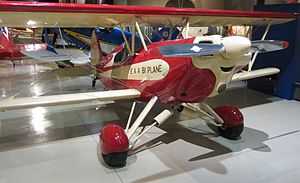EAA Biplane
| EAA Biplane | |
|---|---|
 | |
| EAA Biplane on display | |
| Role | Recreational aircraft |
| Manufacturer | Homebuilt |
| Designer | EAA |
| First flight | 10 June 1960 |
| Unit cost |
approximately $2385 to build in 1971[1] |
The EAA Biplane is a recreational aircraft that was designed in the United States in the late 1950s and marketed as plans for homebuilding.[2]
Design and development
The design was produced for the EAA by a team of Allison engineers led by EAA member Jim D. Stewart. This team took the Gere Sport of the 1930s as their starting point and eventually developed a completely new design.
The prototype was constructed by students at St. Rita of Cascia High School, Chicago and first flew in 1960. Another example named the "Parkside Eagle" was constructed by students of Parkside High School in Michigan in 1971 and test flown for the first time by Paul Poberezny.[3][4] It was a single-seat biplane of conventional configuration, with staggered, single-bay equal-span wings braced with N-struts. The undercarriage was of fixed tailwheel type. The fuselage was built from fabric-covered welded steel tube, and the wings were fabric-covered wood. Plans for the biplane remained available until 1972, by which time some 7,000 sets had been sold. The prototype is now preserved at the EAA AirVenture Museum in Oshkosh, Wisconsin.
Specifications (typical)
General characteristics
- Crew: One pilot
- Length: 17 ft 0 in (5.18 m)
- Wingspan: 20 ft 0 in (6.10 m)
- Height: 6 ft 0 in (1.83 m)
- Wing area: 108 ft2 (10.03 m2)
- Empty weight: 695 lb (315 kg)
- Gross weight: 1,023 lb (464 kg)
- Powerplant: 1 × Continental C85, 85 hp (63 kW)
Performance
- Maximum speed: 105 mph (169 km/h)
- Stall speed: 42 mph (67 km/h)
- Range: 200 miles (322 km)
- Service ceiling: 11,500 ft (3,505 m)
References
- ↑ Leo J. Kohn (Winter 1971). "The true cost of building your own plane". Air Trails: 63.
- ↑ "All these planes you can build from plans". Popular Science: 99. June 1970.
- ↑ Air PRogress: 20. September 1971. Missing or empty
|title=(help) - ↑ "Parkside's Eagle Swoops and Soars". Sport Aviation: 4. September 1971.
| Wikimedia Commons has media related to EAA Biplane. |
- Taylor, Michael J. H. (1989). Jane's Encyclopedia of Aviation. London: Studio Editions. p. 347.
- Jane's All the World's Aircraft 1977-78. London: Jane's Yearbooks. pp. 536–37.
- AirVenture Museum page on type
- airVenture Museum specification page for Biplane with 85 hp engine and open cockpit
| ||||||||||||||||||||||